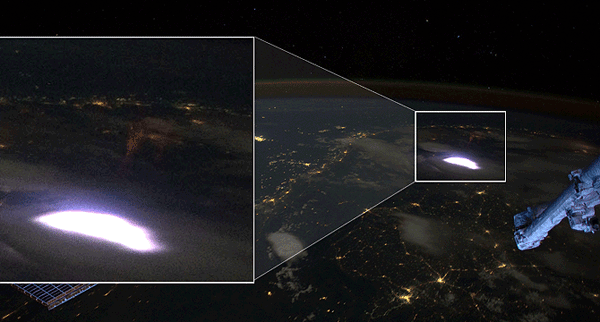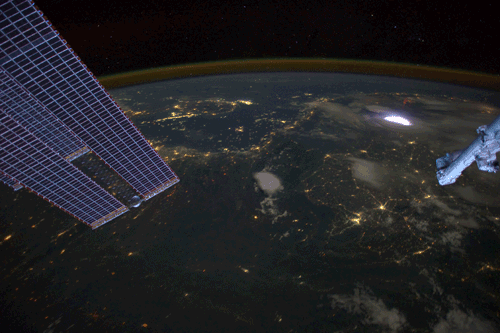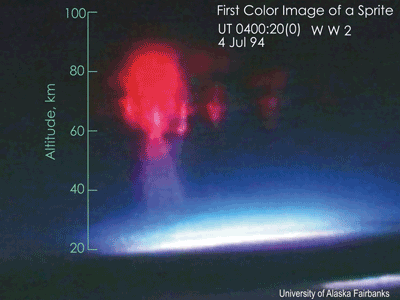Heliophysics nuggets are a collection of early science results, new research techniques, and instrument updates that further our attempt to understand the sun and the dynamic space weather system that surrounds Earth.
High above the clouds during thunderstorms, some 50 miles above Earth a different kind of lightning dances. Bursts of red and blue light, known as “sprites,” flash for a scant one thousandth of a second. They are often only visible to those in flight above a storm, and happen so quickly you might not even see it unless you chance to be looking directly at it. One hard-to-reach place that gets a good view of sprites is the International Space Station. On April 30, 2012, astronauts on the ISS captured the signature red flash of a sprite, offering the world and researchers a rare opportunity to observe one.

A sprite glows red (inset) in this image captured by astronauts on the International Space Station on April 30, 2012. Credit: Image Science & Analysis Laboratory, NASA Johnson Space Center
Indeed, sprites are so hard to catch on film, that pilots had claimed to see them for almost a century before scientists at the University of Minnesota accidentally caught one on camera in July of 1989. Since then, researchers aboard planes have occasionally snapped a shot, but it continues to be difficult to methodically film them. So a group of scientists, along with help from Japan's NHK television, sought them out regularly for two weeks in the summer of 2011.

View larger without inset
Filming at 10,000 frames per second on two separate jets, the team recorded some of the best movies of sprites ever taken – movies that can be used to study this poorly understood phenomenon and the forces that create them. By filming from two jets flying 12 miles apart, the team mapped out the 3-dimensional nature of the sprites. Ground-based measurements rounded out the picture.
“Seeing these are spectacular,” says Hans C. Stenbaek-Nielsen, a geophysicist at the University of Alaska in Fairbanks, Alaska. “But we need the movies, because not only are they so fast that you could blink and miss them, but they emit most of their light in red, where the human eye is relatively blind.”
During those two weeks, the scientists hopped into their planes in Denver, Colo. each evening and chased storm clouds. Just figuring out which direction to fly next was a full time job, assigned to a single person with a computer watching the weather systems. Once a plane found a hot zone of sprites, however, they often lucked into filming numerous sprites in a row. The sprite's first flash is usually followed by a break up into numerous streamers of light – figuring out what causes this divergence is one of the key things researchers will try to understand from these films.

This is the first color image of a sprite ever captured. It was taken in 1994 by a NASA-sponsored project through the University of Alaska Fairbanks (UAF) that flew special cameras on two aircraft flown out of Oklahoma City. Credit: NASA/UAF
The basic understanding of sprites is that they are related to lightning, in which a neutrally charged cloud discharges some of the electricity to ground. Normally negative charge is carried from the cloud to the ground, but about one out of every ten times it's positive charge — and that leaves the top of the cloud negatively charged. With this one in ten chance, the electric field above the cloud is “just right” to produce the sprite, an electrical discharge 50 miles above the thunderstorm.
Typically the weather we experience on the ground is considered to be a separate phenomenon from the weather that goes on higher up in the atmosphere, in the area known as the mesosphere. The sprites show, however, that some fundamental science connects these two regions, opening interesting physics questions about the interchange of energy between them.
Karen C. Fox
NASA Goddard Space Flight Center, Greenbelt, MD
Video
http://www.nasa.gov/multimedia/videogallery/index.html?collection_id=15504&media_id=150386991 Filmed at 10,000 frames per second by Japan's NHK television, movies like this of electromagnetic bursts called “sprites” will help scientists better understand how weather high in the atmosphere relates to weather on the ground. Credit: NHK
Advertisement
Learn more about Nasa





